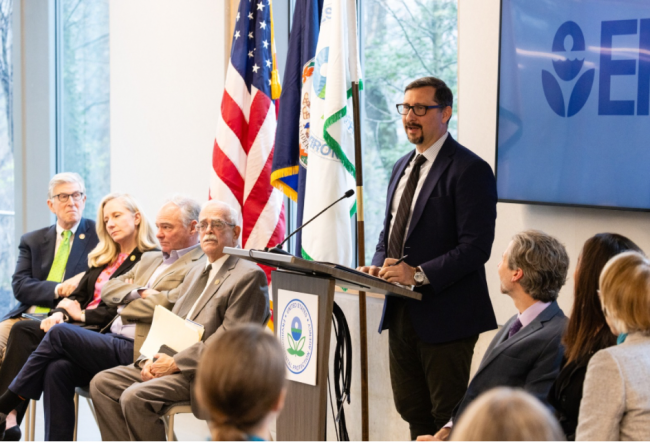
As the rain beat against the windows of the Lubber Run Community Center in Arlington, Virginia, it was particularly poignant to see the rain gardens outside in action. After all, part of the reason why Environmental Protection Agency (EPA) executives, members of Virginia's Congressional delegation, non-profit organizations and local community members were gathered, was to announce a historic amount of funding that will help drive Bay restoration, which may include future green infrastructure projects.
Thanks to the Bipartisan Infrastructure Law, also known as the Infrastructure Investment and Jobs Act, the single largest investment specifically earmarked for Chesapeake Bay restoration was announced today.
"The funding announced today is strategically focused to support conservation projects–and the people who will implement them–over the next four years to restore both water quality and habitat," said EPA's Assistant Deputy Administrator Mark Rupp.
The Chesapeake Bay Trust and National Fish and Wildlife Foundation (NFWF) were awarded $206 million, with $13 million going to the Trust to administer a brand-new community capacity building grant program and $193 million going to NFWF to continue managing the Innovative Nutrient and Sediment Reduction (INSR) and Small Watersheds Grant (SWG) programs.
As part of this $193 million, NFWF also announced today their most recent slate of INSR and SWG awards. These funds cover projects ranging from green infrastructure in suburban and urban areas to agricultural conservation practices on farms to fostering environmental stewardship and environmental literacy.
This year's awardees–82 grants in all–work throughout every jurisdiction (Delaware, the District of Columbia, Maryland, New York, Pennsylvania, Virginia and West Virginia) in the watershed. Some of them include:
-
Arlington County, Virginia was awarded $282,390 dollars for the installation of three green stormwater infrastructure practices that will intercept more than four acres of upland stormwater runoff. The project will conduct a variety of nature-based and watershed educational activities in the community to help engender awareness and watershed protection in the North Barcroft community.
-
Baltimore Tree Trust will use $74,998 to develop curriculum for Baltimore City Public Schools, train City School Groundskeepers on the maintenance of existing trees on school grounds and develop a Tree Lookbook to empower more residents to make decisions about tree plantings in their communities.
-
Center for Watershed Protection was awarded $69,544 to provide technical assistance to Hope Episcopal Church in Lancaster County, Pennsylvania to build capacity for green infrastructure implementation. The project will develop a Green Infrastructure Master Plan for the properties owned by the church, conduct outreach to the congregation of over 100 members and complete designs for two stormwater retrofit projects identified in the Master Plan.
-
The Charles Town General Hospital dba Jefferson Medical Center plans to use $75,000 to provide planning and design support to advance green infrastructure management across two West Virginia University medical campuses. The funding will also be used to develop construction-ready engineering plans for Jefferson Medical Center's Ranson campus, a green medical campus concept plan for Berkeley Medical Center's Martinsburg campus and to help promote green infrastructure as a cost-effective strategy in delivering better environmental, social and health outcomes for the healthcare industry.
-
Defensores de la Cuenca will use $499,591 dollars to deploy La Academia 3.0, a paid, adult Spanish-language watershed training program that promotes knowledge about watershed issues, hands-on experiences and implementation of capstone watershed projects by participants.
A full list of all INSR and SWG recipients is available on the NFWF website.
"Celebrating his historic funding is not just about the present, but about securing a legacy for the future," noted Virginia Representative Gerry Connolly. "These projects will serve as guardians, ensuring that the Chesapeake Bay remains a treasure for generations to come. By investing in restoration and education initiatives, we are not only ensuring we meet our Bay pollution reduction goals, but also cultivating a sense of stewardship for the Bay that will resonate for years to come."












